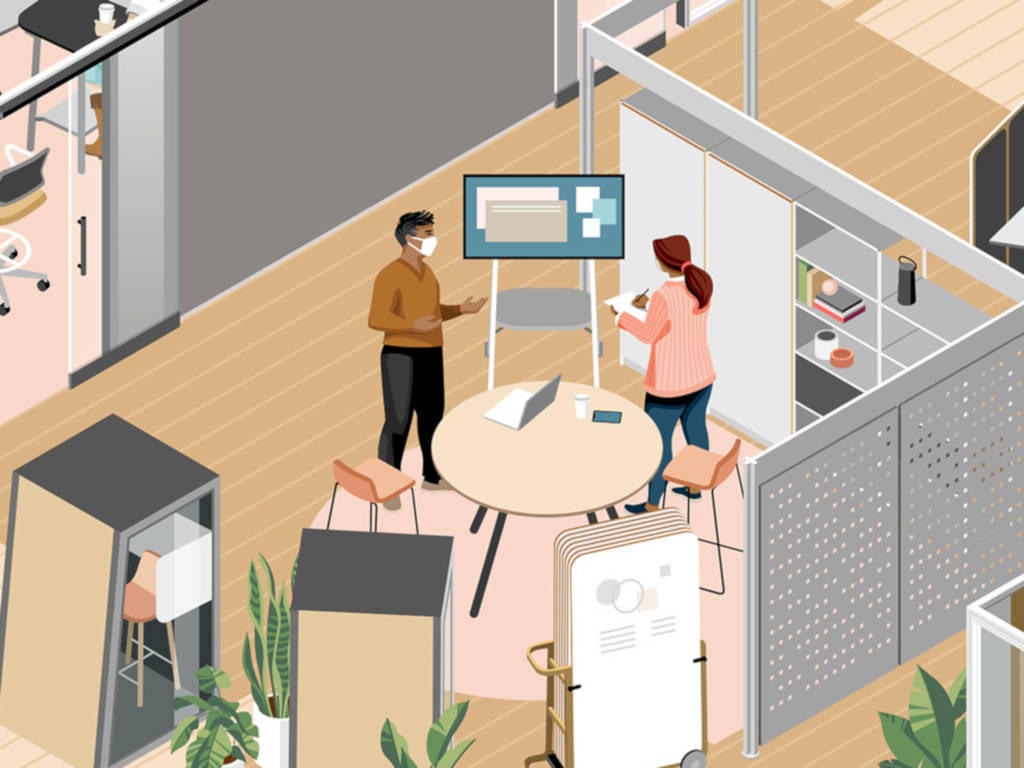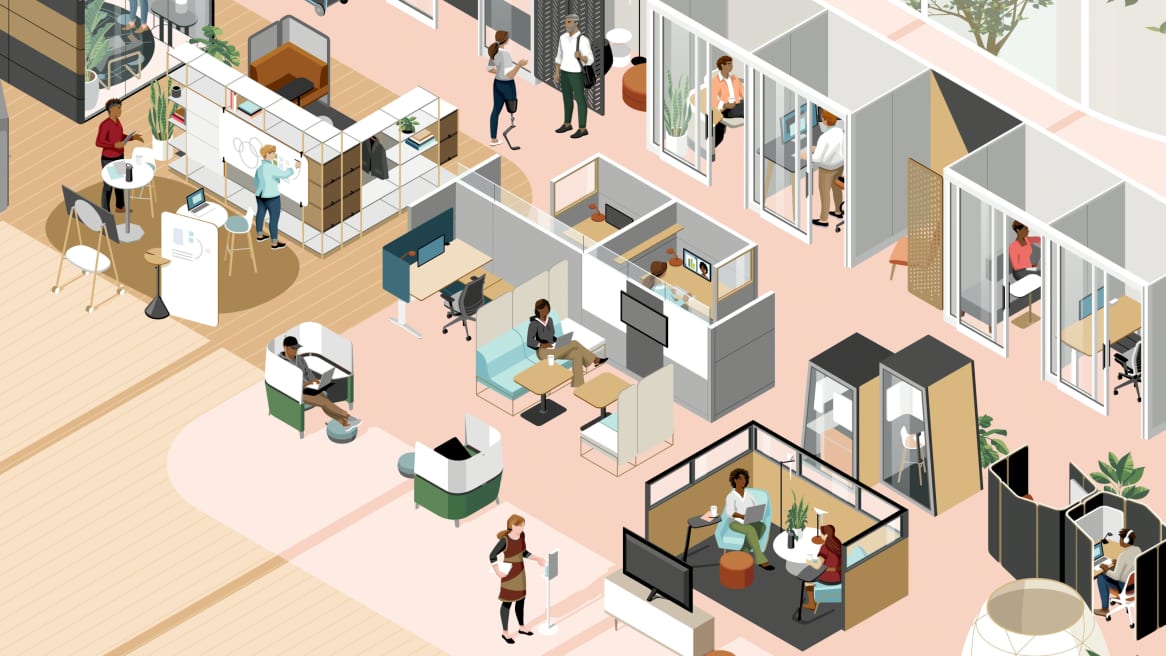Change Management: Manage Change in the Wake of the Pandemic
Consider how you’ll get back to a better work experience. These strategies can help you lead a successful change management effort.
Coming through the pandemic has been life-changing in every way, and a significant part of how you’ll get back to a better work experience will require supporting people through the myriad changes you’ll face. While in some ways, everything will be different, many of the fundamentals will still apply.

The pandemic has introduced tremendous uncertainty and volatility. Coming back from it, and the choices you make—including the ways you guide the organization through this change—will have a long-term impact. They will be a window to your organization’s values, integrity and leadership, and they will have lasting influence. It’s a lot of pressure, yes, but it’s also a lot of opportunity to influence a bright future.
Here’s what you need to know.
We’re all in this together
Perhaps one of the greatest shifts in change management is the audience for change. Pre-pandemic, there were always groups who were going through more change, and those who were going through less change. Even in a large-scale effort, there were people who could provide distance and objectivity based on not going through as much change themselves.
Of course, everything is different today, because every person has been affected by the pandemic in some way. Every region, every position and every type of person—no matter what work they do—has dealt with the impact of the coronavirus. This is both good news and bad news. On the positive side, people can be more empathetic to each other and you can expect bonds to be strengthened based on getting through a tough experience together. However, you’ll have a lot of intentional work to do in planning how you’ll support everyone through the change. When you assess stakeholders, you may need to provide more or less coaching, training or orientation to some audiences, but no one will be untouched, and you’ll need to consider this in the scope and scale for your efforts.
Employee expectations are changing
Humans are resilient and going through the pandemic has changed us all. This will matter to your change management efforts because employee expectations are shifting. Through our Work Better research, we’re learning there are elements of working from home people have loved, and also things they are happy to leave behind. Likewise, there are attributes about the office they have missed and also, things they haven’t. We have also learned they have expanded expectations for control over where and how they work.
All of these shifts in expectations will be critical for you to understand as you lead the change management effort. You’ll need to assess employee expectations and how they’ve shifted, clarify the conditions to which they’ll return—both in the long term and the short term—and help employees adapt over time.
Fundamentals remain – with a few adjustments
With so much that has changed and so much at stake in bringing people back to new conditions, you might conclude that change management must take a right-angle turn as well. But actually, the fundamentals of change management remain—with some important adjustments.
The business and the why.
Whatever changes you’re making, ensure you clearly communicate the why, the context and the connections to the business. This big picture and your vision will be critical for people to understand and get on board. Keep in mind the case you build and the purposes for the change will need to be relevant to the pandemic. Perhaps you’re on course for the changes you had planned originally. Or perhaps you’re using the pandemic to accelerate shifts in your business. Maybe you’re taking brand new steps to bring your workplace in line with your new strategy. Regardless, clearly articulate how your actions are connected to your response to the pandemic, how they make sense given the current context and how they are tied to the success of your business and your employees.
The people and their engagement.
People have been buffeted by the pandemic. Even if their own roles or workloads haven’t changed, they’ve witnessed others’ that have. In leading your change management, make an effort to engage people, involve them and clarify how they fit in the change. Ensure they see their place in the work as well as the workplace. It won’t make sense to give everyone a vote, but they will need to feel they have a voice and they matter.
Behaviors.
Shifting the workplace will catalyze changes in behavior. You’re probably making workplace changes to foster collaboration, speed, innovation or the like. Don’t leave behavior to chance. Clarify what you need from people, what will be different and how you expect the workplace to drive new (or renewed) outcomes. In the short term, you may be taking steps such as performing temperature checks or adjusting circulation patterns throughout your space. In the longer term, routines may shift, but you’ll need to let people know how they should act and interact to be successful and contribute to the business.
Tools and protocols.
Closely related to individual behaviors are group norms and agreements between team members. You’ll want to give more-than-the-usual attention to these because of all the changes the pandemic has wrought. Going forward, you may have more people working away from the office, so you’ll need to ensure team members are communicating about how they’ll stay connected and how they’ll maintain their work flow. Tools and technology must be part of this discussion as well. You may be providing enhanced technology for people at home or in the office, and you’ll need to plan for how employees will learn to use new tools. If team members will be collaborating more frequently from a distance, you’ll want to ensure they are incorporating technology and protocols to reduce presence disparity and foster effective collaboration.
Risk.
Having come through hard times, people may be more sensitive. Provide them with as many specifics as possible about how the workplace will look, how their work process will be accommodated and the changes they can expect. When they go through change, one of people’s biggest fears is they won’t be able to get their work done effectively. Respond to this concern with details about how the work process will be supported by the new work experience. It’s also powerful to share evidence from credible sources—which helps validate the changes you’re making. Overall, when you reduce ambiguity, you reduce the perceived risks—or costs—associated with the change.
Leader accessibility and transparency.
Our research demonstrates that people desire workplaces where leaders are present and accessible, and leadership is always critical for successful change management. In the process of getting back to a better work experience, this is especially true. Because of the pressure and difficulty of the pandemic, leaders’ capabilities have come into focus. Ensure you’re developing leaders and clarifying the behaviors they must model. They’ll need to be transparent, manage by performance more than presence, encourage connections among their team members and embrace new workplace strategies. In addition, leaders should make themselves accessible to answer questions, provide information and pave the way for greater acceptance of change.
It matters how you manage the change
Ultimately, how you manage change matters tremendously, because it is a mirror of your culture, your values, your strengths and—yes—your weaknesses. People will draw conclusions about your organization based on the actual changes you make, and based on how you manage the change process.
When change is managed well, it has positive impacts on engagement, wellbeing and performance. It is also important to attraction and retention—as people watch, assess and commit to your organization.

You can come back from the conditions created by the coronavirus successfully. You can respond to the pandemic effectively. But the real opportunity is to use the recent experience to learn and improve—to work better. The most significant difficulties can be fuel for the greatest improvements. This is the opportunity with change management—to lead the organization through the change and implement a better workplace that supports work and workers in new ways.
We can help
Change Management consulting is available from our Applied Research + Consulting (ARC) team, considering opportunities to plan, implement and sustain change. Our approach is holistic and user-centered, ensuring engagement by connecting organizations to Steelcase’s extensive workplace research.
Successful change management requires an intentional approach and an investment of time and energy. Our ARC team guides you through the process and helps ensure efficiency based on our extensive experience.


